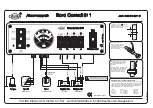
WSM.124
Section B (Engine)
centre camshaft bearing oil feed hole, and the oil
hole feeding to the valve rocker oil feed pipe. See
Fig. 31 and its inset ( I 0). By this means a controlled
quantity of oil Is fed at a much reduced pressure
through an internal pipe to the valve rocker shaft.
Holes in the underside of the rocker shafts feed to
each rocker bearing. Grooves tn the rocker bearing
surface pass oil to drlllings in the rockers which feed
oil to the push rod cup ends and valve rocker ends
that contact the valve stems. Oil from the push rod
cup ends overflows and runs down the push rods
to lubricate the bottom ends of the push rods In the
tappets. Drain holes in each tappet are provided to
prevent the tappets from filling with oil.
OIL SUMP (OIL
PAN)
To remove and refit
Drain oil from sump by removing drain plug at left
side.
Undo eighteen bolts securing sump to lower face
of crankcase. It is advisable to leave one centre bolt
on each side in place until the weight of the sump
can be taken by hand, to avoid distortion of the
joint faces.
To refit
As the sump face is in line with the horizontal axis
of the crankshaft main bearings, a semi-circular cork
joint is used between the front and rear main
bearing caps and the sump, in addition to the
normal face joints at each side.
The semi-circular cork joints should be fitted to the
front and rear main bearing caps after fitting the
cylinder block two bottom face side joints.
The thickness of the semi circular cork joint is
· 180" - • 190" (4·5 - 4·88 mm.) or · 150" - · 160"
(3·8 - 4·0 mm.). These joints are not inter
changeable. The thin joint has replaced the
thick joint and is recognised by its colour dyed ends.
Where the thin joints are used the front and rear
main bearing caps have a casting recess, or cast
protrusions as shown in Fig. 32, by the letter (C).
The identification used on the front main bearing
caps can be seen with the sump in position. A
small number of these bearing caps are without the
casting marks and have rough ground grooves as
illustrated.
When the cast identifying marks are seen (or the
rough ground grooves) on the front and rear main
3rd
re-issue
Page 29
Fig. ]l.
Places at which jointing compound
is used
when
replacing sump and
identifications
used
to
show when THIN
cork joints are fitted.
bearing caps, the thin cork joint MUST be used.
Both ends of each semi-circular corks must be
square and come up to the ends of the two side
joints.
All sump joints should be fitted dry, except when
working from underneath, when the side joints
have to be stuck to the cylinder block bottom face.
A small quantity of quick setting compound should
be applied to the ends of all joints at the points (B)
Fig. 26 to ensu·re a satisfactory oil seal in the corners.
The centre sump bolts should be fitted first and all
bolts progressively tightened.
When dealing with difficult cases of oil leakage, the
front and rear main bearing caps should be removed
and " Wellseal " or other suitable non-setting
jointing compound applied along the front and rear
main bearing recess verticat locating faces (A) as
shown In Fig. 32. The compound must be kept off
of the horizontal butting faces. On replacing the
main bearing caps the jointing compound is trapped
in the small corner clearance between the outside
edges of the bearing caps and the corner of the
locating recess. This prevents oil leakage along the
small clearance that must exist at these points and
along which oil sometimes leaks.
Summary of Contents for ALPINE I SERIES: APLINE II SERIES
Page 1: ......
Page 189: ...Fis 21 Ball pin heirht checkinr fixture in position Details of items 1 to 4 In Fig 22...
Page 208: ...Fla 3 Exploded view of rear axle Hypoid Bevel Drive...
Page 220: ...Page 16 WSM 12 f Section G Rear Axle 0 QQ I I I I I t 0 ii 8 ts t 0 Cl 2 i J...
Page 247: ...Page6 WSM 124 Section J Steering N Iii it...
Page 299: ...Page 40 3 6 7 8 Fis 22 Se rvo unit exploded view Sect WSM 124 ion K Brakes 18 419 GZo 21...
Page 413: ..._ PRINTED IN ENGLAND 9Y WREN PRINTING CQ LTD LONDON...
















































